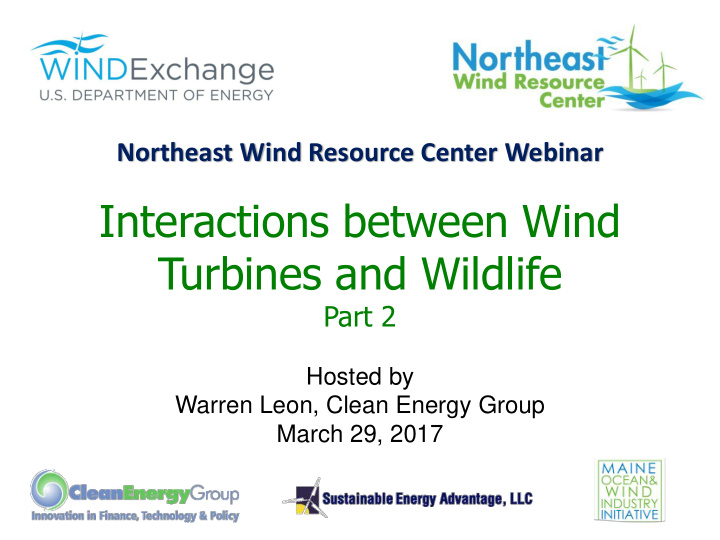



Northeast Wind Resource Center Webinar Interactions between Wind Turbines and Wildlife Part 2 Hosted by Warren Leon, Clean Energy Group March 29, 2017
Housekeeping
About WINDExchange WINDExchange is the U.S. Department of Energy (DOE) Wind Program's platform for disseminating credible information about wind energy. The purpose of WINDExchange is to help communities weigh the benefits and costs of wind energy, understand the deployment process, and make wind development decisions supported by the best available information. On March 11, 2014, the U.S. Department of Energy (DOE) announced six Wind Energy Regional Resource Centers that were selected through a competitive process administered by the National Renewable Energy Laboratory (NREL).
The Northeast Wind Resource Center The Northeast Wind Resource Center (NWRC) is the regional epicenter for salient, unbiased information on land-based and offshore wind energy in the Northeastern United States. Published research, studies, and analyses associated with the issues impacting public acceptance of wind deployment are available in the NWRC Resource Library. The NWRC is supported in part by a grant from the U.S. Department of Energy's WINDExchange program, and is managed by Clean Energy Group, with participation from Sustainable Energy Advantage and the Maine Ocean & Wind Industry Initiative. www.northeastwindcenter.org
Panelists Taber Allison Director of Research and Evaluation American Wind Wildlife Institute Warren Leon Executive Director Clean Energy States Alliance
Wind Energy and Wildlife Question & Answer Presentation Northeast Wind Resource Center March 2017 1
Collisions and Turbine Height • Barclay, R.M.R., Baerwald, E.F., Gruver, J.C., 2007. Variation in bat and bird fatalities at wind energy facilities: assessing the effects of rotor size and tower height. Can. J. Zool. 85, 381 – 387. doi:10.1139/Z07-011 • Loss, S.R., Will, T., Marra, P.P., 2013. Estimates of bird collision mortality at wind facilities in the contiguous United States. Biol. Conserv. 168, 201 – 209. doi:10.1016/j.biocon.2013.10.007 2
Anthropogenic Sources of Avian Fatalities Source Number Birds per Year Reference Buildings 365 – 988 million Loss, et al. 2014 Communication Towers 6.5 million Longcore, et al. 2012 Transmission Lines – 12 – 64 million Loss, et al. 2014 collisions and electrocutions Vehicles 89 – 340 million Loss, et al. 2014 Wind Energy 214,000 – 368,000 Erickson et al. 2014 Cats 1.3 – 3.99 billion Loss, et al. 2013 [Estimated 10-20 billion land birds in North America]
Wind & Communication Towers Wind Turbines 1 Communication Towers 2 Total Estimated Mortality 214,000 to 368,000 6.5 million Birds Per Structure/MW 3 – 5 per MW ~90/tower 3 – 15 per turbine Black-throated blue warbler 0.029 – 0.043% of 4.9% of population/year population/year 1 Erickson et al. 2014. A Comprehensive Analysis of Small-Passerine Fatalities from Collision with Turbines at Wind Energy Facilities. PLOS One 9 (9): 1-18. 2 Longcore, et al. 2012. An Estimate of Avian Mortality at Communication Towers in the United States and Canada. PLOS One. 7 (4): 1-17
Adjusted Diurnal Raptor Fatality Estimates Total Carcasses per Year Region Total MW in Low High Region East 13,363 944 1,954 West 62,226 7,287 15,727 Overall 75,589 8,281 17,681 Fatality estimates < 0.5% of breeding population total for all raptor species
Guidelines 2012 2011 6
Status of Research on Wind-Wildlife Interactions Wind Turbine Interactions with Wildlife and their Habitats • Collision Mortality • Direct and Indirect Habitat Effects • Cumulative Impacts • Avoiding and Minimizing Impacts https://awwi.org/resources/summary-of-wind-wildlife-interactions-2/ 7
Technological Innovations Landscape Assessment Tool About Library Analysis >1,000 data layers 8
9
Wind Turbine Passerine Mortality: Population Impacts 1 North American % population affected Species Population (high estimate) Estimate Black-throated blue warbler 2,100,000 0.043% Tree swallow 17,000,000 0.043% Horned lark 80,000,000 0.038% Brown thrasher 4,900,000 0.035% Yellow-throated vireo 3,500,000 0.035% Spotted towhee 2,200,000 0.033% Sedge wren 6,200,000 0.028% Bushtit 2,300,000 0.025% Western meadowlark 30,000,000 0.020% Rose-breasted grosbeak 4,100,000 0.020% 1 Erickson et al. 2014. A Comprehensive Analysis of Small-Passerine Fatalities from Collision with Turbines at Wind Energy Facilities. PLOS One 9 (9): 1-18.
Thank you for attending our webinar Warren Leon Clean Energy Group/ Northeast Wind Resource Center wleon@cleanegroup.org Northeast Wind Resource Center: www.northeastwindcenter.org DOE Wind Exchange: http://energy.gov/eere/wind/windexchange
Recommend
More recommend